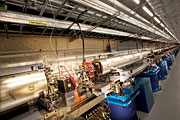- Number 299 |
- November 9, 2009
Science begins at the world’s most powerful X-ray laser

Thirty-three LCLS undulator
magnets will create intense X-ray
laser light from a pulse of
electrons traveling 99.9999999
percent the speed of light.
(Image credit: Brad Plummer,
SLAC.)
The first experiments are now underway using the world's most powerful X-ray laser, the Linac Coherent Light Source, located at DOE's SLAC National Accelerator Laboratory. Illuminating objects and processes at unprecedented speed and scale, the LCLS has embarked on groundbreaking research in physics, structural biology, energy science, chemistry and a host of other fields.
In early October, researchers from around the globe began traveling to SLAC to get an initial glimpse into how the X-ray laser interacts with atoms and molecules. The LCLS is unique, shining light that can resolve detail the size of atoms at ten billion times the brightness of any other manmade X-ray source.
“No one has ever had access to this kind of light before," said LCLS Director Jo Stöhr. “The realization of the LCLS isn’t only a huge achievement for SLAC, but an achievement for the global science community. It will allow us to study the atomic world in ways never before possible.”
Currently, user-assisted commissioning is underway, with researchers conducting experiments using the Atomic, Molecular and Optical science instrument, the first of six planned instruments for the LCLS. In these first AMO experiments, researchers are using X-rays from the LCLS to gain an in-depth understanding of how the ultra-bright beam interacts with matter.
Early experiments are already revealing new insights into the fundamentals of atomic physics and have successfully proven the machine’s unique capabilities to control and manipulate the underlying properties of atoms and molecules. Earlier this month, researchers used the LCLS’s strobe-like pulses to ompletely strip neon atoms of all their electrons. Researchers also watched for two-photon ionization—an event where two photons pool their energy to eject a single electron from an atom. Normally difficult to observe at X-ray facilities, researchers at the LCLS were able to study these events using the extreme brightness of the laser beam.[Melinda Lee, 650.926.8547,
melinda.lee@slac.stanford.edu]
